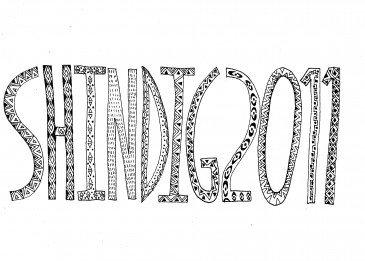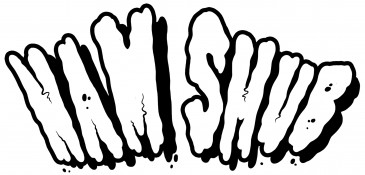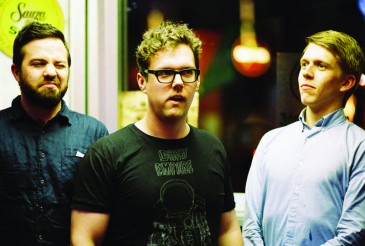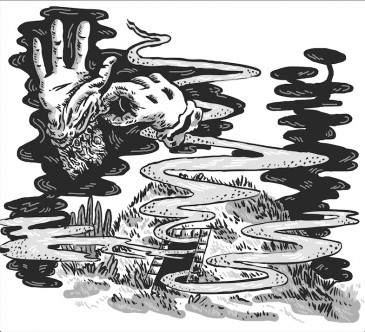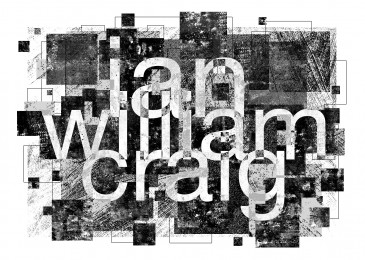
Ian William Craig is not your traditional musician. Blending analog synthesizers, operatic singing, and years of artistic experience through a series of hand-made tape echoes and loops, Craig’s rare performances are as much about him struggling with the risk of unpredictable reel-to-reels as they are about crafting articulate, thematically-rich drone soundscapes. We met at the Wise Lounge on a quiet autumn night to talk about his latest records, Meaning Turns To Whispers, Cloudmarks, and Heretic Surface, released together but recorded years apart.
Craig is humble, optimistic, and amongst the nicest people I’ve ever interviewed. An award-winning print-maker, his music is a natural extension of the same themes that won him notoriety as a visual artist. “During school, my own expression of music was peripheral,” he said. “I was interested in notions of decay and deterioration, because in print, you really don’t have that much to do with [the process] beyond throwing the plates into an acid bath every once in a while and seeing what comes out. So it accrues memory and becomes a history of itself.”
Inside of the experimental envelope, there’s something wonderful and mystifying in Craig’s body of musical work. Much like the rabbit hole Alice stumbles down, the trilogy of “sculptures” are full of the surreal and chaotically beautiful, as Craig attempts to mimic “what memory might sound like, or what a body sounds like.” The result is a rich cascade of positive emotions, cosmic accidents and faulty echoes, reminiscent of early Brian Eno or Eluvium, with the warm presence of old tape under each track.
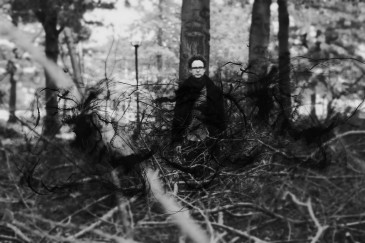
“[These records] use imperfection to explore the concepts of failure and decay that I was trying to make into beautiful things during my time as a print-maker.” Much of the ugliness Craig hints at is the result of his manipulation of old reel-to-reel machines and tape decks, all of which he’s modified himself. “Sitting in my apartment and making absolutely crazy bat-shit terrible things was actually really liberating,” he notes. “I really enjoy the absurd aspect of tape machines; I circuit-bend them, but I tweak a thing and a strange noise happens — it’s totally unknown. The physical nature is very appealing to me. I can touch the tapes. I can scrape them… I don’t feel like I’m alone on stage.”
Of Craig’s performances, no two could ever really be compared by the same means. Surrounded by his substantial tape equipment and an analog synthesizer, the only constant is Craig himself, and half the appeal is seeing him corral each machine into doing what he wants; reel chirps, microphonic hum, and magnetic distortion phase in and out of each set like Christmas lights in between beautiful synth arpeggios and ariatic singing, courtesy of his extensive opera and choir training. He’s humble about the experiences, recalling: “Making music seems a lot more improvisational to me [than making visual art]. It can be a happening, it can be just me getting up in front of people and fucking around, I never know what’s going to happen.” Perhaps what makes Craig’s set so much fun to watch is that the crowd seems to be just as much in the dark as he himself is.
It’s fitting that, despite the focus on decay and the way art is affected by time and space, Craig’s music is always positive and calming instead of overbearing and sinister. Mangled piano chords still retain a sense of beauty, even amidst the chaos Craig has subjected them to, which is surprising considering the way they came into being. “I was living with my sister in Edmonton, and during the ridiculously cold winter, I gutted her piano and mic’d it up in a whole bunch of weird ways. I recorded probably 20 hours of material, and after listening to it I was amazed at how much it sounded like sentimental crap. At that point I was really trying to express something, and afterwards I thought the only way through would be to destroy the recordings, and that’s what Meaning Turns To Whispers is. It’s completely mangled to remove that struggle for expression. I realized at the end of that album that I didn’t want to express, I just wanted to explore.”
For more sights and sounds from Ian William Craig, visit: ianwilliamcraig.com


